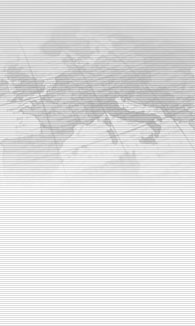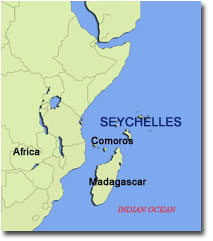 |
 |
|
|
|||||||||||
| Population | ||||||||||||
The total population is around 80,000 with 90% of them live in Mahˆm. The ethic groups are mixed of French, English, Indian, Chinese and African origins. The sex ratio of male to female in Seychelles is 0.93 to 1 The literate rate in Seychelles is around 58%. |
||||||||||||
| Language | ||||||||||||
The official and spoken language is Creole, which is a French patois, French and English. English is widely spoken in business and tourism related establishments. |
||||||||||||
| Currency | ||||||||||||
| The official currency is Seychelles Rupee (SCR). | ||||||||||||
| Economy | ||||||||||||
|
The main industry in Seychelles is tourism which employs 30% of the workforce and contributes 70% of hard currency earnings. Recently, the government promotes the farming, small-scale manufacturing and fishing industries, especially tuna sector, in order to switch the dependence on tourism. Further, due
to the establishment of Seychelles International Business Authority
and a suite of progressive laws, the incorporation of offshore structures
are facilitated which in turn enhance the foreign investment and
leads to the rapid growth in financial segment. For example, an
increasing number of international banks and insurance companies
have established either branches or subsidiaries in Seychelles.
Hence more and more local management, accounting and legal firms
are formed to provide clients with support. |
||||||||||||
| Government | ||||||||||||
|
Seychelles is discovered by a Portuguese explorer named Vasco de Gama
and the first French settlement was established on St. Anne Island
in 1770. But in 1814, Seychelles together with Mauritius were ceded
to Great Britain under the terms of The Treaty of Pars, and became
an independent republic within the British Commonwealth. The Government is composed of the president, which is both the chief of state and head of government, and a 39-member unicameral National Assembly or Assemblee Nationale. 25 of them are elected by popular vote, while 9 numbers are allocated on a proportional basis to parties winning at least 10% of the vote. General elections are held at intervals of not longer than five years. |
||||||||||||
| Law and Taxation | ||||||||||||
|
The legal system is based on English Common Law, French Civil Law,
and Customary Law. The judicial power of Seychelles is vested in the Judiciary, consisting of the Court of Appeal, Supreme Court and other subordinate courts or tribunals established under the Constitution. The concept of the separation of powers, as defined by the Constitution, guarantees the independence of the Judiciary. The principal corporate legislation is the International Business Companies Act 1994. |
||||||||||||
| Local Infrastructure | ||||||||||||
|
The Port of Victoria possesses more than 6,000 sqm of covered storage
space, which is also well equipped with modern cargo handling equipment.
The Seychelles International Airport is one of the finest in the Indian Ocean region. Besides the national flag carrier, Air Seychelles, the airport is served by a number of other airlines. |
||||||||||||
| Advantages | ||||||||||||
| -
Political and economic stability. - No exchange control regulations. - No tax on offshore profit other than Government License fee. - No disclosure necessary. - Flexible Company law. - Excellent worldwide communication facilities. |
||||||||||||
